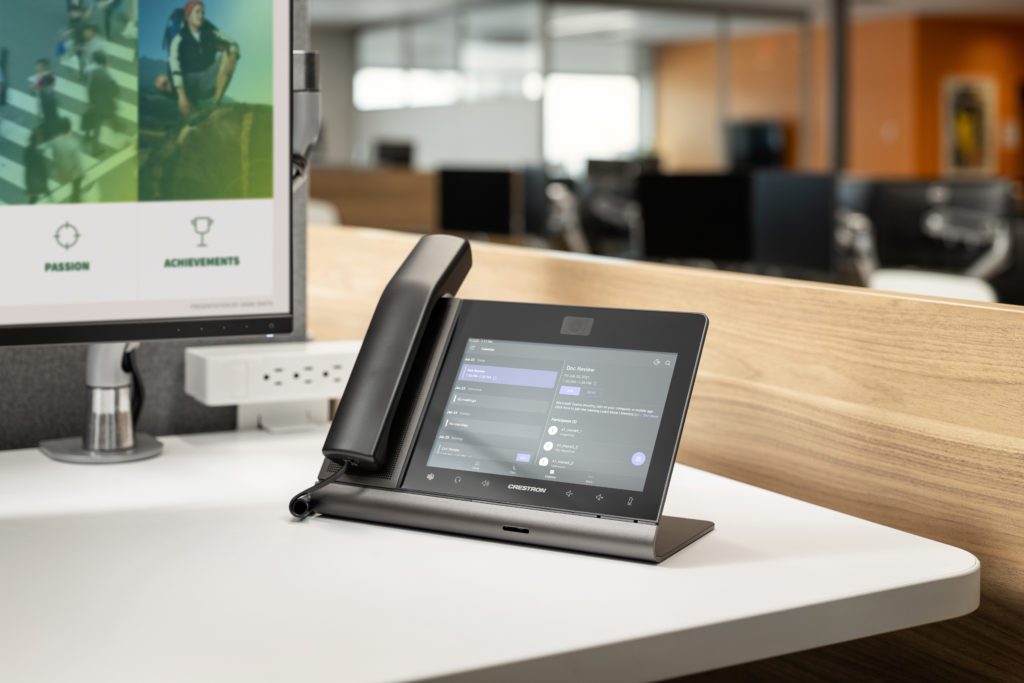Founded in 1972, Crestron Electronics is a household name in technology automation. In its near 50-year history, the company has developed a wide range of hardware and software solutions, including home automation systems, unified communications platforms, and workplace technologies.
As we emerge from the life- and business-altering COVID-19 pandemic, how and where we work has also undergone rapid transformation. With new approaches developing to bridge the many hybrid work models to choose from, we spoke with Crestron’s Vice President of UC Enterprise Andrew Gross about how the company approached product development in the face of accelerated digital transformation, what the “equity of experience” means for the future of work, and how Crestron’s partnerships with Zoom and Microsoft are shaping how CIOs and IT administrators are integrating and managing unified communications systems.
Llanor Alleyne: Crestron has been a big player in the home and enterprise tech space over the years. How has the pandemic reshaped your approach to product development, especially as it pertains to digital transformation, UC and UCC?

Andrew Gross: The COVID-19 pandemic sparked a workplace evolution, with the majority of companies moving their teams to remote seemingly overnight. Before the onset of the pandemic, most businesses averaged 7 to 15 percent of rooms with videoconferencing capabilities. By the end of March 2020, videoconferencing became the most critical communications tool for keeping businesses connected.
Now, 18 months later, we’ve learned a lot more about how to support the future of work and we continue to make changes and roll out new product updates and solutions. One example of a solution we developed using these learnings is the Crestron Flex Phones for Microsoft Teams, which we released a few months ago to address the surge in videoconferencing and increased reliance on Teams to support enterprise collaboration. By handling all audio, video, and content viewing, the Crestron Flex Phones free other devices, like a laptop or PC, to be used as a dedicated, purpose-built productivity tool for collaboration. This helps foster a collaboration experience that is more fruitful and less frustrating by minimizing inefficient task-switching, streamlining ad hoc communication, and allowing users to segment their schedule and workload more effectively.
The shift to work-from-home and now hybrid work models have pushed the needle on enterprise digital transformation across most industries. How has Crestron addressed this shift from a partnership standpoint, especially in your collaborations with Zoom and Microsoft Teams?
We believe workplace automation technology that not only comes loaded with seamless connectivity to software like Zoom or Microsoft Teams, but also provides data analytics around room space and usage for decision-makers, are key to long standing success. Collaboration software has moved from a helpful feature to an essential enterprise tool to keep teams connected and productive.
Our partnership with Microsoft and Zoom has blossomed into more than just a transactional “their software running on our hardware” relationship into one that is much more integrated, beginning at the design and development stage. Together, we work closely to ensure the next iteration of Crestron’s products better support the technology developments for the future of work that Microsoft and Zoom are creating. We work synchronously to create solutions for customers that deliver the best workplace experience, every time. From speech recognition technology that is optimized by the hardware it’s loaded on to camera support that enables the latest in Teams and Zoom software features to better democratize the meeting space, we are creating technology that best serve the way enterprise customers are working today.
With hybrid and remote work becoming a long-term workplace format, it is not enough for enterprises to only offer collaboration software for personal devices. It must be available natively through an array of enterprise hardware, easily accessible with one click of a button or by plugging in a personal device, in any meeting or workspace in an office. Our partnerships are essential to enabling these capabilities.
Also read: 5 Unified Communications Trends Defining a Post-COVID-19 World
In both of these partnerships, there has been a great focus on the “equity of experience.” Can you talk us through what that means and what that looks like in a hybrid work environment?

The equity of experience refers to the notion that any meeting participant, regardless of where they are physically opting to work, should feel fully integrated into the meeting’s collaboration and conversation.
Pre-pandemic, remote meeting participants were often unintentionally regarded as fringe attendees, with the focus being on the in-person group. After the shift to remote work, and recently, a hybrid model, the opposite is now true — in-person meeting attendees are now second-class in a virtual meeting. This is because video and audio are not dedicated to a single person as they are for virtual attendees, and the in-person group are all vying to be seen and heard. To create equitable meetings, employees need to be able to join any meeting, connect, and participate as efficiently as they would in person or virtually, every time.
any meeting participant, regardless of where they are physically opting to work, should feel fully integrated into the meeting’s collaboration and conversation.
Crestron, working with Microsoft and Zoom, are changing this. Using Crestron’s pioneering knowledge and innovation in audio and video solutions, we are bringing to market hardware that, when paired with the Teams and Zoom software features, democratizes the meetings experience, regardless of where you are, by creating individual streams of video per person and enhancing the audio functionality to be clearer and more personal.
There is also the experience of IT teams to consider in the future of hybrid work. On the surface, adding more devices to an enterprise network can be a burdensome task for IT departments, but IT teams can benefit from choosing a single vendor for a company’s UC technology as long as it is easy to deploy and manage in the cloud. Pre-pandemic, a mid-size office may have only had a small team managing IT needs for personal computers and laptops, along with a handful of meeting spaces that had less sophisticated AV or communication technology. This same IT team is now tasked with managing not only the IT systems, but communications technology that is likely being deployed across all the meeting spaces and offices.
We recognized that need at Crestron, even before the pandemic, as the digital transformation movement accelerated and developed XiO Cloud, a service that offers management, monitoring, and configuration of up to thousands of devices in the enterprise in the same time it takes to configure one.
What does Crestron bring to the table when trying to achieve “equity of experience” when integrating hybrid workspaces?
The reality is that the workplace of the future will need to be more than just a space for employees to come, do their work, and leave. It will have to be re-configured to become a space where collaboration and connection come first and employees can be transient, while also having the resources they need to effectively work and communicate together in-person.
A big component of supporting this change is creating meeting and huddle spaces that support equitable experiences — these changes must begin before a meeting space is even reserved. For example, in a Crestron workspace, remote scheduling capabilities allow participants to reserve and schedule rooms in advance to ensure availability and that the appropriate technology is present — this saves time and effort, boosting efficiency. Once in a room, cost-effective and easy to deploy occupancy sensors “turn on” rooms as participants enter, and initiate touch-free room and device automation. The meeting room is made up of the latest UC technology — a display (or two) that offer native support for Teams or Zoom, and a wireless presentation system that supports the latest video conferencing and collaboration technology, voice control, and allows for quick access for participants to present and share via their own devices efficiently. Each meeting participant, regardless of where they are located, can see and hear the conversation clearly, and share content within seconds — driving more productive and equitable hybrid meetings.
IT admins and CIOs should invest in technology that can be easily updated, managed, and configured as workplace dynamics continue to shift.
Behind the scenes, the meeting space is driven by data and high-performance networks. A cloud-based platform enables AV/IT departments and help desks to remotely deploy, manage, and monitor room and device usage. Sensors that collect occupancy data, send data and provide analytics to a cloud platform, help to ensure rooms are not overcrowded. This data also enables managers to understand the utilization of spaces to calculate real estate needs as changes continue post-pandemic.
UC and UCC have experienced a boom spurred on by the pandemic. As we reach the end of this global health crisis, how do you see IT administrators and CIOs further utilizing these tools to continue reshaping the nature of work and work environments? Where does Crestron position itself in continuing to shape that future?
Employees choosing hybrid work models will have little tolerance for an office environment that hinders their ability to easily connect and collaborate consistently. Therefore, the entire technology backbone of the hybrid office must work synergistically. Offices must be reconfigured and redesigned as not just a space with desks, computers, and meeting rooms, but a truly collaborative and dynamic place to meet and work together, from wherever employees are.
Featured IT Asset Management Software
1 Deel
Simplify your Asset Management today with Deel IT—an IT Asset Management software that helps global teams simplify employee device and app management. This comprehensive solution provides centralized control, enhanced security, increased efficiency, and cost reduction. By automating routine tasks, optimizing resource allocation, and leveraging real-time insights, Deel IT empowers organizations to make data-driven decisions, improve service delivery, and mitigate security risks.
2 Setyl
Gain full visibility and control over your IT assets, licenses, usage and spend with the Setyl IT asset management (ITAM) platform. Use Setyl to manage your hardware assets and equipment, software licenses and subscriptions, vendors, admins and users in one place, including through 100+ integrations with your existing systems. Helping you to: 1. Streamline your IT operations, including on/offboarding 2. Identify and eliminate wasted IT spend 3. Prepare for your ISO 27001, SOC 2 and other audits.
Having the ability to create flexible workspaces with scalable technologies in today’s office building is extremely valuable. IT admins and CIOs should invest in technology that can be easily updated, managed, and configured as workplace dynamics continue to shift.
At Crestron, we recognize that the way we work is still evolving. Our goal is to continue to listen to customer needs and industry changes, and develop solutions that make getting to work easier, more efficient, and impactful, to support more productive and equitable work environments.
Read next: Best UCaaS Providers 2021




